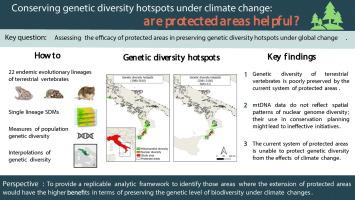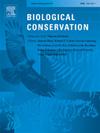Conserving genetic diversity hotspots under climate change: Are protected areas helpful?
IF 4.9
1区 环境科学与生态学
Q1 BIODIVERSITY CONSERVATION
引用次数: 0
Abstract
The conservation of genetic diversity is a major target of the Kunming-Montreal Global Biodiversity Framework and of the EU Nature Restoration Law, as it provides populations with the potential to evolutionary adapt to the ongoing environmental challenges. However, genetic diversity has often been neglected in the conservation planning, and data on the extent to which it is currently preserved by protected areas are scanty. Here, we assessed the efficacy of protected areas in preserving genetic diversity hotspots under global change. Focusing on the Italian peninsula inside the Mediterranean global biodiversity hotspot, we (i) investigated the patterns of genetic diversity of endemic terrestrial vertebrates, (ii) assessed how much genetic diversity is currently covered by protected areas considering both nuclear and mitochondrial DNA, and (iii) estimated the impact of projected range shifts caused by climate changes on the conservation of genetic diversity patterns. We found that protected areas cover <20 % of the areas of high genetic diversity for most of the investigated taxa, and fail to cover almost all multispecies genetic diversity hotspots. Furthermore, our results showed that mitochondrial DNA is not a reliable proxy for nuclear genome diversity, and its use in spatial conservation planning might lead to ineffective initiatives. Finally, we estimated that the extent of genetic diversity covered by protected areas will dramatically decline in the near future (2050). These results identify major gaps in current protection of genetic diversity and provide concrete guidelines to plan area-based conservation initiatives that meet biodiversity conservation targets for 2030.

保护气候变化下的遗传多样性热点:保护区有用吗?
保护遗传多样性是《昆明-蒙特利尔全球生物多样性框架》和《欧盟自然恢复法》的一个主要目标,因为遗传多样性为种群提供了在进化过程中适应当前环境挑战的潜力。然而,遗传多样性在保护规划中往往被忽视,目前有关保护区对遗传多样性的保护程度的数据也很少。在此,我们评估了保护区在全球变化下保护遗传多样性热点的功效。我们以地中海全球生物多样性热点地区的意大利半岛为重点,(i) 调查了当地陆生脊椎动物的遗传多样性模式,(ii) 评估了目前保护区对核DNA和线粒体DNA遗传多样性的覆盖程度,(iii) 估计了气候变化引起的预计分布区转移对遗传多样性模式保护的影响。我们发现,保护区覆盖了大多数被调查类群遗传多样性较高地区的 20%,几乎未能覆盖所有多物种遗传多样性热点地区。此外,我们的研究结果表明,线粒体DNA并不是核基因组多样性的可靠替代物,在空间保护规划中使用线粒体DNA可能会导致无效举措。最后,我们估计在不久的将来(2050 年),保护区覆盖的遗传多样性范围将急剧下降。这些结果找出了当前遗传多样性保护工作中的主要差距,并为规划基于区域的保护措施提供了具体指导,以实现 2030 年的生物多样性保护目标。
本文章由计算机程序翻译,如有差异,请以英文原文为准。
求助全文
约1分钟内获得全文
求助全文
来源期刊

Biological Conservation
环境科学-环境科学
CiteScore
10.20
自引率
3.40%
发文量
295
审稿时长
61 days
期刊介绍:
Biological Conservation is an international leading journal in the discipline of conservation biology. The journal publishes articles spanning a diverse range of fields that contribute to the biological, sociological, and economic dimensions of conservation and natural resource management. The primary aim of Biological Conservation is the publication of high-quality papers that advance the science and practice of conservation, or which demonstrate the application of conservation principles for natural resource management and policy. Therefore it will be of interest to a broad international readership.
 求助内容:
求助内容: 应助结果提醒方式:
应助结果提醒方式:


